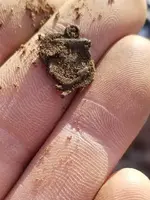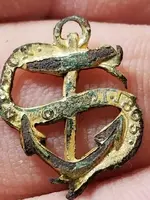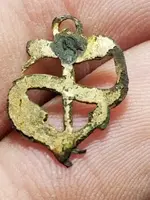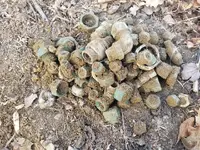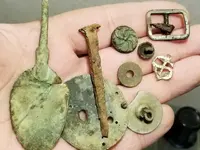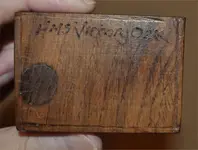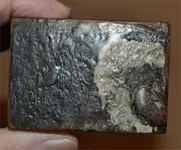HEAVYMETALNUT
Silver Member
Got out to a cellar hole foundation and it was hit pretty hard. a couple buttons. I got a good signal and dug down and out popped a brass fitting, then another and more and more . 42 pounds of brass fittings in one hole lol.
My find of the day was the anchor piece. I had no idea what I had until I got home. thinking just a brass charm from WWII era the whole time.
cleaning it up I see wording. NELSON Oct,21 1805. I guess these were made for a short time after his death and are not very common. I was pretty stoked at what it actually was.
The Battle of Trafalgar (21 October 1805) was a naval engagement between the British Royal Navy and the combined fleets of the French and Spanish Navies during the War of the Third Coalition (August—December 1805) of the Napoleonic Wars (1803—1815).[SUP][3][/SUP] As part of an overall French plan to combine all French and allied fleets to take control of the English Channel and thus enable Napoleon's Grande Armée to invade England, French and Spanish fleets under French Admiral Villeneuve sailed from the port of Cádiz in the south of Spain on 18 October 1805. They encountered the British fleet under Admiral Lord Nelson, recently assembled to meet this threat, in the Atlantic Ocean along the southwest coast of Spain, off Cape Trafalgar, near the town of Los Caños de Meca. Villeneuve was uncertain about engaging the British, and the Franco-Spanish fleet failed to organise fully. In contrast, Nelson was decisive, directing the British fleet into two columns sailing straight into the enemy to pierce its wavering lines.
In a particularly fierce battle, 27 British ships of the line fought 33 French and Spanish ships of the line. The lead ships of the British columns were heavily battered, with Nelson's flagship HMS Victory nearly disabled, but the greater experience and training of the Royal Navy overcame greater numbers. The Franco-Spanish fleet lost 22 ships while the British lost none. Nelson himself was shot by a French musketeer, and died shortly before the battle ended.
My find of the day was the anchor piece. I had no idea what I had until I got home. thinking just a brass charm from WWII era the whole time.
cleaning it up I see wording. NELSON Oct,21 1805. I guess these were made for a short time after his death and are not very common. I was pretty stoked at what it actually was.
The Battle of Trafalgar (21 October 1805) was a naval engagement between the British Royal Navy and the combined fleets of the French and Spanish Navies during the War of the Third Coalition (August—December 1805) of the Napoleonic Wars (1803—1815).[SUP][3][/SUP] As part of an overall French plan to combine all French and allied fleets to take control of the English Channel and thus enable Napoleon's Grande Armée to invade England, French and Spanish fleets under French Admiral Villeneuve sailed from the port of Cádiz in the south of Spain on 18 October 1805. They encountered the British fleet under Admiral Lord Nelson, recently assembled to meet this threat, in the Atlantic Ocean along the southwest coast of Spain, off Cape Trafalgar, near the town of Los Caños de Meca. Villeneuve was uncertain about engaging the British, and the Franco-Spanish fleet failed to organise fully. In contrast, Nelson was decisive, directing the British fleet into two columns sailing straight into the enemy to pierce its wavering lines.
In a particularly fierce battle, 27 British ships of the line fought 33 French and Spanish ships of the line. The lead ships of the British columns were heavily battered, with Nelson's flagship HMS Victory nearly disabled, but the greater experience and training of the Royal Navy overcame greater numbers. The Franco-Spanish fleet lost 22 ships while the British lost none. Nelson himself was shot by a French musketeer, and died shortly before the battle ended.
Attachments
Last edited:
Upvote
29



